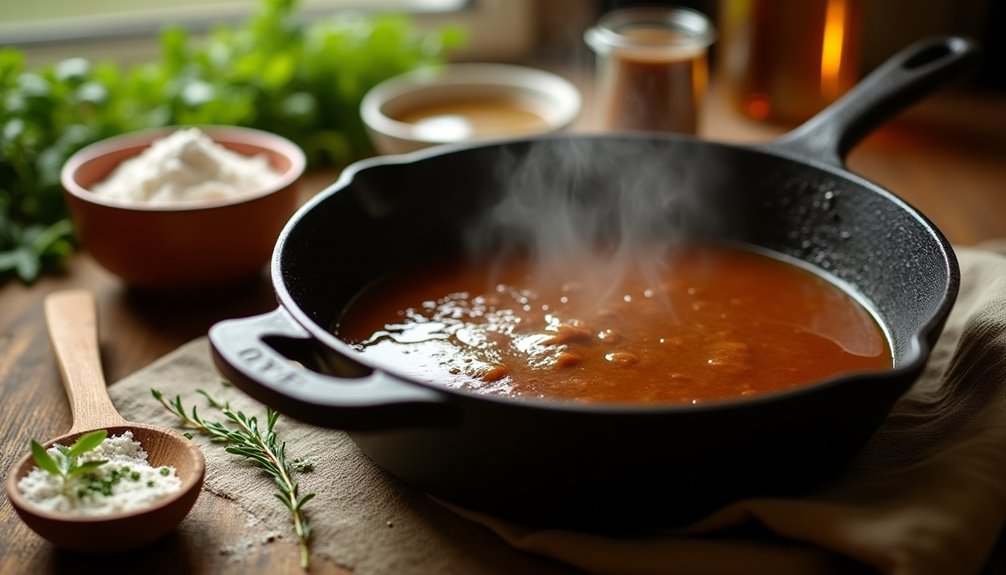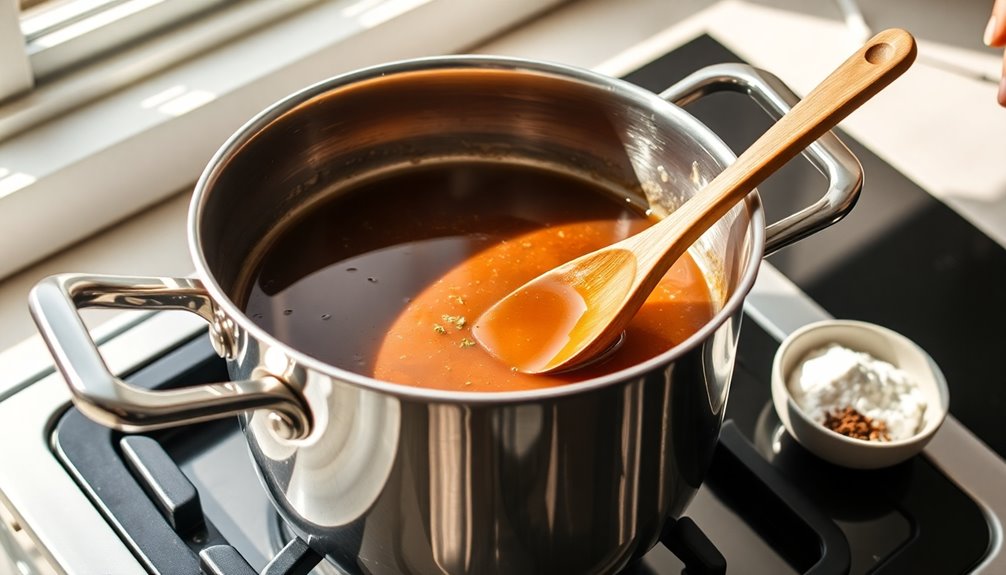To make gravy with pot roast juice, start by straining the drippings through a fine mesh sieve to remove solids. Whisk together ¼ cup of flour with the strained liquid, adding salt and pepper for seasoning. Bring this mixture to a boil, then reduce the heat and let it simmer for 5 to 10 minutes until thickened. If needed, use a cornstarch slurry to reach your desired consistency. Keep tasting and adjusting the seasoning for the best flavor. There’s more to explore about enhancing your gravy. You can also experiment with additional ingredients such as sautéed onions, garlic, or fresh herbs to enrich the flavor profile of your gravy. For those curious about how to use pot roast juice, consider drizzling it over mashed potatoes or using it as a base for soups and stews for added depth. Don’t hesitate to store any extra gravy in the refrigerator; it can elevate many meals throughout the week.
Key Takeaways
- Strain pot roast drippings through a fine mesh sieve to remove solids for a smooth gravy base.
- Whisk ¼ cup all-purpose flour with the strained drippings, adding salt and pepper for seasoning.
- Bring the mixture to a boil while whisking constantly to avoid lumps, then reduce heat to simmer.
- To thicken, use a cornstarch slurry if the gravy is too thin, stirring it into the simmering mixture.
- Taste and adjust seasoning before serving the rich gravy over pot roast or mashed potatoes.

When you've finished cooking a delicious pot roast, don't let those savory drippings go to waste—turn them into a rich, flavorful gravy! It's the perfect accompaniment to your roast, and making it's easier than you might think.
You'll start by straining the pot roast drippings through a fine mesh sieve to remove any solids. This step ensures your gravy has a smooth texture, free from any unwanted bits. Once strained, transfer the liquid to a skillet to begin the gravy-making process.
Now, let's create a roux, which is a classic base for many sauces. In your skillet, whisk together ¼ cup of all-purpose flour with the strained pot roast drippings. As you mix, add in ¼ teaspoon each of salt and freshly ground black pepper for seasoning. This combination not only thickens the gravy but also enhances its flavor. Keep stirring frequently to avoid lumps. You want to bring this mixture to a boil, so stay close and keep that whisk moving!
Once it reaches a boil, reduce the heat and let it simmer. This will allow the gravy to thicken to your desired consistency, which typically takes around 5 to 10 minutes. If you're looking to elevate the flavor even more, consider adding a dash of Worcestershire sauce or sautéed onions and mushrooms while it simmers. These additions can really bring your gravy to life, making it a standout feature of your meal.
What if your gravy turns out too thin? Don't worry; you can easily fix that with a cornstarch slurry. To create this thickening agent, mix 2-3 teaspoons of cornstarch with some cold water in a small bowl. Once it's well combined, stir this slurry into your simmering gravy. This method helps thicken the gravy without altering its flavor too much. Just remember to keep stirring as it cooks, allowing it to thicken gradually.
As your gravy simmers, taste it and adjust the seasoning as needed. Sometimes, a pinch more salt or a dash of pepper can make all the difference.
Once you're satisfied with the flavor and consistency, it's time to serve. Ladle your rich gravy over slices of pot roast or mashed potatoes, and watch it transform your meal into something truly special.
In just a few simple steps, you've taken those pot roast drippings and crafted a delicious gravy that enhances the entire dining experience. So, next time you cook a pot roast, remember the magic that lies in those drippings. With a little effort, you can turn them into a dish that everyone will love. Enjoy your homemade gravy, and savor every bite!
Frequently Asked Questions
How Do You Thicken Pot Roast Juice for Gravy?
To thicken pot roast juice for gravy, you can use a cornstarch slurry or a flour-based method.
Mix about 2 tablespoons of cornstarch with cold water for every cup of liquid, then stir it in while simmering.
Alternatively, combine equal parts flour and fat in a pan until golden, then add the pot roast juice gradually.
Always whisk continuously to prevent lumps and ensure a smooth, flavorful gravy that thickens nicely.
What to Do With Juice From Pot Roast?
You might think pot roast juice is just leftover liquid, but it's packed with flavor and can elevate your meals!
You can use it as a base for soups or stews, adding depth to your dishes. Alternatively, reduce it in a pan to concentrate the flavors, perfect for drizzling over veggies or proteins.
Don't toss it out—transform that juice into a culinary gem that enhances your next meal!
How to Make Gravy From the Roast Juice?
To make gravy from roast juice, start by straining the juice through a fine mesh sieve to eliminate solids.
In a skillet, combine the strained juice with flour, about ¼ cup for every 3 cups. Season with salt and pepper, then bring it to a boil while whisking continuously.
If you want extra flavor, add Worcestershire sauce or sautéed onions.
If your gravy's too thin, mix cornstarch with cold water and stir it in to thicken.
How to Make Gravy From Pot Roast Broth?
To make gravy from pot roast broth, start by straining the broth to remove any solids.
In a skillet, combine the strained broth with an equal amount of flour or cornstarch—usually about ¼ cup of flour for every 3 cups of broth.
Heat the mixture while stirring continuously until it thickens.
Season with salt, pepper, and optional herbs for extra flavor.
Serve it warm over your favorite dishes and enjoy!
Conclusion
With a final stir of the ladle, you've transformed pot roast juice into a velvety gravy that dances across your plate. As the rich aroma envelops your kitchen, it beckons loved ones to gather around the table. Each spoonful is a warm embrace, binding flavors together like cherished memories. So, pour generously over your meal, and let this luscious creation elevate your dining experience to one of comfort and joy, where every bite is a celebration.
Cindy thoroughly researches juicing trends, techniques, and recipes to provide readers with practical advice and inspiration. Her writing style is accessible, engaging, and designed to make complex concepts easy to understand. Cindy’s dedication to promoting the advantages of juicing shines through her work, empowering readers to make positive changes in their lives through the simple act of juicing.











